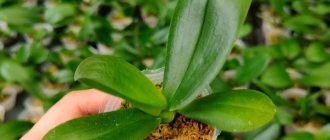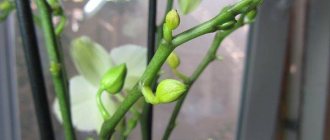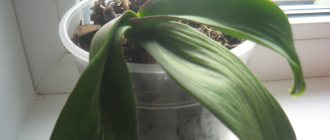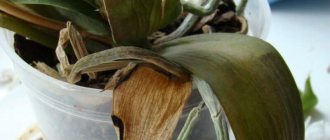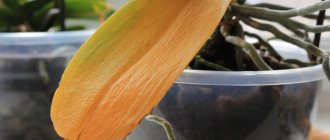People whose homes are decorated with tropical plants often try to water them abundantly, since in nature they live in a humid climate. There is an opinion that excess moisture quickly evaporates and does not cause harm. This is true for most houseplants, with the exception of orchids. Their root system is sensitive to waterlogging. If you overwater the flowers, the roots may rot. Excessive watering is the most common cause of their death. Therefore, every orchid grower should be familiar with the sequence of steps on what to do if an orchid is flooded.
Why does an orchid die?
The main reasons for the death of the culture are the inconsistency of the conditions of detention with the requirements. Significant temperature changes, waterlogging of the substrate, and critical lack of lighting can be detrimental to it.
Most often, problems arise during the cold season. The flower reacts negatively to the following factors:
- dry air during heating operation;
- cold coming from the glass when kept on the window;
- watering with hard water;
- overheating or burns when exposed to sunlight;
- constantly wet substrate combined with low temperature;
- excess or improper application of fertilizers;
- violation of root aeration due to too compacted substrate;
- infection by insect pests or fungal diseases.
If the necessary conditions are not created and the factors affecting the well-being of the flower are not eliminated, it will soon begin to die.
Why did the leaves turn yellow and wither?
Do not be alarmed if a single yellow leaf appears on an orchid. If the others have not lost their characteristic color, and the plant is at least two years old, it is quite possible that the leaf blade is dying off for a natural reason. She has lived out her allotted time. In some species, leaves live for about five years, in others no longer than one year. If the leaf has aged, it is carefully cut off from the base so that it does not take away nutrients from the young shoots.
Yellowing of one leaf can occur due to natural reasons; it dies from old age. It must be cut off carefully.
But when all the leaves lose their elasticity and turn yellow, it means something is going wrong. Most likely, the hydration regime is disrupted, and from excess water, the orchid suffocates because the outer covering tissue is destroyed.
Sometimes it happens that the humidity is normal, but the orchid still suffers. This may occur due to hard water. High salt content forms a limescale deposit on the substrate and on the surface of the roots. Which makes it difficult for nutrients to access.
Settling the water will help solve the problem. This method is suitable when the rigidity is not too high. To neutralize highly saline water, add citric acid at the rate of 1 g per 2 liters.
How do you understand that Phalaenopsis has begun to perish and die?
You can determine that an orchid is experiencing problems by its appearance. It is worth paying attention to the presence of the following signs:
- sluggish, gradually yellowing leaves;
- yellowing of shoots, starting from the crown;
- absence of buds (more than 3 months);
- changing the position of the plant in the pot;
- drying and hanging of aerial roots;
- green plaque and algae inside the pot.
If at least one of these signs is present, it is worth removing the flower from the flowerpot and inspecting the root system. Signs of problems with roots:
- brown or black color;
- soft to the touch;
- release of liquid when pressed;
- filamentous structure.
Signs of orchid overflow
At different periods of life, plants need certain volumes and frequency of watering. Orchid roots have spongy covering tissue. Its function is to absorb nutrients from the air. If the substrate in the pot constantly remains wet, the flower begins to suffer from lack of nutrition and metabolic disorders. As a result, the roots rot and the plant dies.
The signs of orchid bay are as follows:
- Wilting of leaf blades. They lose turgor and become wrinkled.
- Change in leaf color. It becomes less saturated, turns pale, and a yellow tint appears. This process can first be noticed at the tips of the leaf blades, and gradually it spreads to the entire leaf.
- Formation of stains. They signal that the flower is affected by pests or diseases.
- Root system rotting. It is covered with a grayish-brown coating, after which the roots completely rot.
On a note! In order to notice in time that problems have arisen with the orchid’s root system, and not to flood it in the future, it is recommended to plant plants in transparent containers.
If at least one of the listed symptoms of overwatering appears, you must immediately save the flower.
What to do if the plant is flooded?
Excessive moistening of the substrate is the main mistake of novice gardeners. The roots of an orchid are special, and you cannot water it like other crops. You can tell that a plant is flooded by the color of the roots in the pot. Then the leaves begin to wrinkle and the buds fall off. If measures are not taken, the flower will soon begin to die.
Important! Most often, overflow occurs if, when immersing a pot in a container of water, they forget to remove it in time. A substrate overflowing with moisture is detrimental to an orchid.
Eliminating flooding and overflow
The only way to cope with flooding or overflowing is to transplant the flower into a fresh substrate and replace the pot. Operating procedure:
- The plant is carefully removed from the pot. It cannot be pulled out, otherwise the roots will break. It is better to carefully cut the pot into two parts and remove them.
- The substrate is cleaned from the roots, washed with warm water and inspected.
- Use sharp, disinfected scissors to cut off the rotten parts.
- After drying, the sections are powdered with crushed charcoal or cinnamon.
- Spray the roots with fungicide and leave the rosette to dry for a day.
- Drainage is placed at the bottom of the new pot, freshly prepared substrate is poured in a thin layer and the orchid is placed on it. The free space between the roots is covered with substrate, leaving the root collar on the surface.
Carefully! Inexperienced gardeners try to dry a waterlogged substrate by heating it with a hair dryer. The hot air flow acts on the flower like a real hurricane. From such help he will not recover, but will definitely die!
How not to overwater an orchid?
The plant requires strictly controlled moistening of the substrate in different phases of development, at different temperature and humidity levels in the room. For an orchid, both overdrying and overmoistening are equally dangerous.
On average, the frequency of watering is as follows:
- during the active growing season - 2 times a week;
- during flowering and in very hot periods - every other day;
- during the rest period - once every 2-3 weeks.
When regulating moisture, it is also worth considering the type of orchid:
- Cymbidium, Phalaenopsis, Paphiopedilum are watered when perspiration disappears on the inside of the walls of the pot.
- Cattleya, Oncidium, Odontoglossum, Dendrobium require the substrate to dry completely before the next watering.
- Vanda needs daily spraying from a spray bottle.
Important! For irrigation, use exclusively soft, settled or filtered water at a temperature of 30-35 degrees.
Step-by-step steps on how to perform resuscitation
To save an orchid from rotting when overwatered, you need to do the following:
- Carefully remove the flower from the planting container.
- Rinse the roots.
- Inspect them.
- Cut away damaged areas to healthy tissue. Plants that have more than half of their roots preserved must be replanted.
- To disinfect, treat the sections with cinnamon powder or charcoal.
- Remove yellowed leaf blades.
- Wash the new planting container with laundry soap.
- Heat the fresh substrate in the oven.
- Soak the soil in water to soften the edges of the pine bark that is present in the substrate. They should not injure the root system.
- Cover the bottom of the pot with a thin layer of drainage, add a little prepared soil.
- Place the orchid in the planting container. The base of its leaves should be located a few centimeters lower than the edge of the pot.
- Carefully straighten the root system.
- Fill in the moist soil, leaving an empty space around the base of the leaves. This will protect the root collar from rotting.
Advice! You cannot water the flower immediately after transplanting. This should be done after the substrate has dried.
Helping the orchid during bud formation and flowering
Regardless of whether the flooded plant is in the flowering or dormant period, it is inspected and transplanted into another pot. Follow the instructions above. The temporary absence of buds and flowers is the least damage compared to the possible death of the plant.
What to do if mold appears
If mold is noticed in the planting container, the orchid must be urgently removed from the pot, inspected and planted in a new one. If this is not possible in a short time, you can treat the soil with a fungicide.
What to do if there are bugs in the pot
When overwatered, orchids most often develop podura. These are tiny white jumping insects. To get rid of them, just dry the substrate. Insecticides can be used to control other pests.
How to revive a flower at home?
The method of resuscitation of a dying flower depends on its condition and the problem that has arisen.
How to revive rotten roots?
Exotica with completely rotten roots are restored after their complete removal. The gardener’s task is to grow a new root system on the surviving rosette.
According to gardeners, the most effective way is to hang the rosette above the water:
- After removing the rotten roots, the sections are dried for several hours and treated with charcoal.
- Water is poured into a transparent vessel and the rosette is hung with a wire so that the lower part is located 1-2 cm short of the liquid.
- The container is installed in a warm (23-25 degrees) room in a place with diffused but intense lighting.
- During the process of growing roots, monitor the liquid level and add it as necessary. To prevent the leaves from drying out, they are wiped with a solution of succinic acid or the drug “Doctor Foley”. This will help the orchid gain strength and energy.
New roots are formed within 2-2.5 months. As soon as their length reaches 5-6 cm, the plant is planted in a pot with sphagnum moss. This material has good moisture capacity and at the same time increased breathability, which will help the weakened plant recover faster. After complete resuscitation and root growth, the orchid is transplanted into a substrate familiar to this type of plant.
How to save an orchid when it is overheated?
Keeping the crop in a too hot, dry room or in direct sunlight can also cause its death. Signs of overheating:
- wilting leaves (often with light spots or yellow tips);
- yellowish tint and wrinkling of roots;
- dryness and fragility of aerial roots.
If the plant overheats, remove it from the windowsill to a cool place to cool.
Important! A flower damaged by high temperature can be watered only after it has cooled, after 3-4 hours. Immediate moistening of the substrate will cause instant death of the roots!
How does a flower grow when there is not enough light?
Signs of a lack of lighting are wrinkled or small leaves of a dull shade. The flower looks drooping, unhealthy, and does not bloom for a long time. The roots gradually begin to rot as photosynthesis processes in them are disrupted.
It will be possible to revive the plant only if it is provided with bright, diffused lighting for at least 12 hours a day. The best place for growing is an east or west window. In winter or in cloudy weather, the orchid is illuminated with fluorescent or phytolamps.
If the plant is sick
Overmoistening or overheating of a crop is dangerous not only in itself. They provoke the development of diseases on the plant. Signs of diseases depend on their type:
- Fungal - appear as a white or gray coating, spots, stains on the leaves.
- Bacterial - cause rotting of roots, blackening of leaves and pseudobulbs, followed by their death. Often the leaves become covered with weeping spots, and an unpleasant odor emanates from the plant.
The drug Fitosporin has proven itself well in the treatment of fungal diseases. They are treated 2-3 times with an interval of 7 days.
Bacterial diseases can only be treated at an early stage. First, all affected parts of the plant are removed, healthy parts are wiped with antibiotic slurry. Experts advise using the drug Chlorhexidine. To restore after treatment, reduce watering and lower the temperature to 22-23 degrees.
How to save an orchid if the roots are dead
In this case, you cannot replant the orchid right away. First you need to create favorable conditions.
- For this purpose, a greenhouse is built. You will need a plastic vessel with a little water poured into the bottom.
- The orchid is freed from all rotten and suspicious roots, cutting down to living tissue. Sprinkle with finely ground cinnamon or crushed charcoal. These substances form a protective shell, protecting the plant from the penetration of pathogens and pests.
- Dry it in a well-ventilated place, but not in the sun, but in partial shade. The cuts should tighten. An open wound can become infected.
- After drying, the plant is placed in a bowl so that the roots do not come into contact with the water, but hang over it.
- During resuscitation of the root system, it is sprayed twice a day from a spray bottle.
- As the water evaporates, it is added to the original level.
If everything goes well, new roots will appear. When they grow to six centimeters, the orchid can be planted in the substrate.
Quick help for an orchid
In saving an exotic animal (when diagnosing problems), it is important to provide him with first aid correctly. Any violation of the appearance of the plant requires immediate action:
- swelling, plaque and yellowing of leaves is caused by a fungus. The affected parts are removed, the cut areas are treated with a fungicide;
- when bacterial spots appear on old leaves, they are pruned and treated with activated carbon;
- the plant with dried leaves and roots is transplanted into a new substrate;
- if voluminous waxy growths or holes are noticed on the leaves, treat them with insecticides against pests.
Category: “Questions and answers”
Question No. 1. Is it possible to save an orchid if all its roots have rotted away?
Answer.
In any case, it's worth a try. The plant must first be freed from all affected and suspicious parts. After this, they are placed in a homemade greenhouse.
Question number 2 . If the roots of an orchid are rotten, can it be replanted during flowering?
Answer.
Experts do not recommend touching plants during flowering, except in emergency cases. Root rotting is one of them. To save the plant, decorativeness will have to be sacrificed. Otherwise, you can lose not only the flowering, but the entire orchid. If transplantation is the only way out for salvation, then it is carried out during any growing season.
How to prevent Phalaenopsis from dying?
Careful adherence to recommendations for living conditions and care rules helps prevent problems when growing orchids:
- Compliance with watering standards. Phalaenopsis is a special flower that needs to be “watered” periodically. The next portion of moisture is added to the substrate only after the roots have absorbed the previous one. The root system must breathe, so it cannot constantly be in water.
- Providing intense lighting for at least 12-14 hours a day. Without a large amount of scattered sunlight, the plant loses its immunity. The roots weaken and cannot provide it with nutrients.
- Proper feeding. The main enemy of the orchid, which leads to rotting of the roots, is an excess of nitrogen. Fertilizing is carried out taking into account the phase of vegetative development of the plant. In this case, the dosage is reduced by 2-3 times to avoid overfeeding.
- Maintaining a humidity level of at least 60%. If there is not enough moisture in the air, the pot with the plant is placed on a tray with expanded clay. It must first be filled with water, an automatic humidifier must be installed in the room, and additional spraying of the leaves and roots should be carried out.
You shouldn’t throw away a limp, dried out or even rootless orchid. With some effort and patience, she can be saved. A life-loving flower will “take advantage of the chance for salvation,” the main thing is to choose the right method. Before using any method of resuscitation, you should first familiarize yourself with the recommendations of specialists and experienced flower growers. Wrong actions in this situation can aggravate the deplorable condition of the plant.
5/5 — (1 vote)
Emergency measures against improper care
In such a situation, there is only one way out - transplantation with a complete replacement of the nutrient substrate . If the roots are rotten, pathogens have most likely spread into the soil. They accumulate in the substrate and on the walls of the pot. Therefore, be sure to replace the dishes and substrate. It’s better if both are completely new. This way you can avoid further infection after transplantation.
Tip #1 . Before planting an orchid in a fresh soil mixture, you need to treat it against possible pathogens and pests. To do this, the substrate is heated in the oven at a temperature of +700 for 15 minutes. You can fill it with hot water three times.
Even healthy orchid roots are very fragile. And, if they begin to rot, then they need to be handled especially carefully. To remove the root system from an old pot, it is better to cut it into 2 - 3 parts. You should not wish for the dishes; they are still not suitable for further use.
Before preparing an orchid for relocation, it is washed under warm, running water.
Rotten and damaged roots need to be shortened to living, healthy tissue and treated with a protective agent.
Then they begin to inspect the plant. Preparation and transplantation are carried out following these recommendations.
Water resuscitation of orchids
If using a greenhouse is not possible, you can restore a lost orchid using ordinary water or solutions that stimulate tissue growth. It is desirable that the water be soft, without salts.
Restoring and saving an orchid must begin with pruning and disinfection of the roots. Next, take a deep container, fill it with warm water and place the flower so that the root neck is above the surface.
The plant must remain in the liquid for at least 6 hours. Next, the water is drained and the roots are dried. The procedure is repeated daily at the same time, for example, in the morning.
To make the process more successful, you can make solutions with the addition of:
- natural honey – 1 spoon per liter;
- chelated iron – 2 drops per liter;
- sugar - a tablespoon per liter;
- root growth stimulator - according to instructions.
You cannot keep the plant in liquid for a long time - this impairs the respiration of the tissues, and they will die anyway.
It is recommended to alternate nutrient solutions with clean water so as not to overload the diseased plant.
Resuscitation using a greenhouse
To maintain the same humidity and temperature, it is better to place a dying orchid without roots in a greenhouse.
Conditions for greenhouse maintenance:
- humidity above 70%;
- temperature 25 – 28 degrees;
- Daylight hours are 14 hours.
The growth point, cleared of rot and dry root shoots, must be placed in a special substrate. It is prepared as follows:
- Expanded clay is poured into a transparent glass with holes.
- Steam the sphagnum moss and lay the next layer on top of the expanded clay.
- Next is the rosette left without leaves.
The substrate should be moist, but not wet. It is not possible to water frequently, since the walls of the greenhouse retain evaporation and provide the necessary conditions. It is recommended to ventilate the greenhouse in the evening or at night to remove unnecessary gases.
Video: How to revive an orchid without a root system
Usually the growth of new roots is visible after 2 weeks. Until they reach a length of 3–5 cm, the plant will remain inside the greenhouse. Then you can begin to ventilate it and then replant it.
The role of irrigation
Watering orchids is one of the main and incredibly important actions for caring for a plant. There are a variety of reasons affecting the development and healthy flowering. All of them are the result of compliance with all watering rules.
In the world, the orchid family has 796 genera and 25 thousand species, which grow in different parts of the globe. Each genus and species has certain conditions. The usual place for orchids to grow is stones, rocks and tree branches, in contrast to plants growing in our climate with their characteristic soil and soil. It is necessary to take into account the peculiarities of watering, which are very different from the methods we are used to.
Many gardeners strive to purchase the rarest possible type of orchid for their indoor collection. Their places of growth are located in different parts of the Earth, but their great love for the tropical climate makes it impossible for them to grow only in Antarctica.
In tropical areas, the plant does not receive enough nutrients in the soil and is forced to draw them from various sources of water in the meager layers of the soil, as well as in tree trunks. In the tropics, drought alternates with long rainfalls, which replenish the water balance for flower growth. The florist is obliged to replace such rains for the orchid with regular access to moistening the roots.
An important condition in watering is maintaining fluid balance. After all, its excess can lead to flooding and rotting of the flower and lead to death. Lack of moisture is also dangerous for fragile natural creatures. Together with water, the plant receives nutrients in order to grow strong, healthy and pleasing to the eye, a green representative of your room. By depriving it of regular watering, you are depriving the flower of life.
Note! When watering an orchid, it is recommended to use soft water purified from tap impurities. You can clean it using a filter or by boiling, after cooling the water.
Prevention and further care
You can prevent re-flooding only by carefully monitoring your beauty. By following the described watering rules, you are no longer afraid of repeating past mistakes. Give flowers more of your precious time and attention, because this is a small life in a pot on the window of your house, enchanting with its beauty and sophistication.
Don't skimp on food and fertilizer for her. By providing it with all the necessary vitamins and microelements, it will bloom and fill the house with its fragrance much longer than usual.
It is worth feeding with substances that include potassium and phosphorus. It is better to exclude nitrogen-containing elements. They lead to increased growth of leaves rather than buds. Phosphorus is necessary for plants during the flowering period. Its deficiency will lead to the appearance of significantly smaller buds and their number. Fortunately, on the shelves of flower shops you can find complementary foods with a different spectrum of action.
The orchid is mentioned in legends and tales. New Zealand myths say that the mother of this flower was the rainbow itself. Many popular expressions and poems are dedicated to this unusually exquisite flower. The magical haze that envelops the history of this flower has not yet been dispelled, and perhaps you will be lucky enough to reveal all the magic of the orchid.
You have the opportunity to grow a truly exotic flower right at home. You just need to follow a number of rules and pay due attention to the plant.
In addition to the gulf, the orchid may experience other problems and diseases, for example, plaque, wilting, drying out, yellowing, spots on leaves and flowers, white roots, falling leaves, mold. Why this happens and how to help the plant - read on our website.
How to water correctly?
Each type of orchid requires a special regime and method of watering. One loves constantly moist soil, the other needs moisture after the soil dries out. The frequency of watering is determined from a number of factors :
- Type of orchid.
- Season.
- Flowering and dormant period.
- Air humidity.
- A container in which a flower grows.
orch >All the most interesting things about Orchids!
Most novice flower growers do not know what to do if they have flooded an orchid with water, or how to revive it. As you know, the most convenient method of watering is called “immersion”. It consists of immersing a flower pot inside a basin of warm water for ten to fifteen minutes. Sometimes, for some reason, the owner of a flower forgets to take it out, so the soil becomes oversaturated with water, which threatens the plant’s death.
The first sign of an overwatered orchid can be called wrinkled leaves; if the situation occurs during the flowering phase, the buds and opened flowers will fall off. At the first alarming symptoms, immediate action must be taken. The only correct answer to the question of what to do when an orchid is flooded is an unscheduled transplant. It is strictly forbidden to dry soil using artificial heat sources. Some hobbyists make the irreparable mistake of placing the pot on top of heating radiators or drying the soil with a hair dryer.
External signs indicating that the plant is flooded
It is not immediately possible to identify a flooded flower externally. The orchid first reacts with its roots, and only after some time it can be seen on the leaves that the flower needs help.
And yet, if you suspect a plant is flooded, then you need to examine its roots. Rotting elements are immediately visible. They are dark, wrinkled and hollow.
If measures are not taken at this stage, then the next manifestation will be wilting of the leaves. They will wrinkle, turn yellow, dry out and fall off. This signal cannot be ignored. And although it is already very late, after resuscitation, the plant may still be saved.
Root extension
A way to revive an orchid at home without roots and with limp leaves:
- Inspect the roots and lower part of the peduncle. If they are dry, trim them sparingly. Dip it in crushed activated carbon and leave the plant to dry on the substrate. You can't water it.
- Leaves should not be touched unless they fall off on their own.
- Wipe the remaining leaves daily with a cotton swab soaked in a solution of succinic acid, even if they have withered but still retained their green color.
After a month, a small root will form, which cannot yet be immersed in the substrate until it reaches a length of 3–5 cm. Continue the procedure of growing roots until there are 3–4 of them.
Important! The process may take a long time. Sometimes it takes 2 - 3 years for the roots and leaves to recover
How to get rid of mold
A common situation is when the roots are not damaged, but there is already mold in the pot. This is perhaps the only case when you can try to do without a transplant, neutralizing the overflow. And then, only if it was already produced not so long ago, and the substrate is in good condition.
The way out of this situation is to water it with a fungicide solution, which we wrote about above. Mold is also a fungus, and this measure will get rid of it.
But after this you need to very carefully monitor the condition of the roots. Since the process of rotting could have already begun, but it was simply not yet noticeable visually. At the first signs of rotting, you need to immediately proceed to replanting.
To summarize, we will say that the roots of the orchid, as an epiphytic plant, are unusual. They require light and air. They not only nourish the plant, but also take part in photosynthesis. Their surface contains many hollow cells, which in structure resemble a sponge, and by the same principle absorb moisture from the air. And it is their clogging that leads to the death of the plant. Stagnant moisture does not allow them to breathe, which leads to rotting.
We invite you to watch a video about saving an orchid:




